


B‑1239R
Revised June 2022
Karen Panter, Extension Horticulture Specialist,
Department of Plant Sciences, University of Wyoming
Chris Hilgert, Extension Educator,
Department of Plant Sciences, University of Wyoming
Landscaping with
Container Gardens
Planting flowers and other plants in containers is a great way to add splashes of color to homes, offices, and landscapes. Container gardens are also ideal for those having small yards or those who have physical impairments but still like to garden, page 5. Most herbaceous plants, and even some dwarf shrubs and trees, can be successfully grown in containers.
Container Type
There are two types of containers: porous and non-porous.
Porous types, like those made of clay, allow for air and water movement. The potting mix in these pots can dry out quickly.
Non-porous containers, like plastic, glazed pottery, and metal, do not lose moisture as quickly. Metal pots, page 4, and plastic posts, page 3, are examples of non-porous containers while the clay container, page 2, is porous.
Almost anything can be used as a container, provided it’s clean and has holes in the bottom to allow drainage. This helps prevent root rot by keeping roots out of sitting water. If no holes are present, drill a few.
Container size is a consideration. The rule of thumb is the larger the container, the longer it will take to dry out and less frequent watering will be needed. Small pots and hanging baskets may require watering several times a day in Wyoming’s dry air. Also, over time, salt residues may accumulate on containers. Scrubbing or soaking the containers will eliminate most of this buildup.
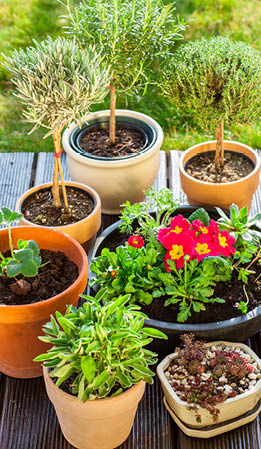

Clay and pottery tend to be heavy. Once they’re full of potting mix and plants, they are not easy to move. Plastic and wood are lighter weight but may be top-heavy, depending on what’s planted in them. Plant caddies or mobile plant stands on wheels are available; these are made for setting large containers on and moving them.
Growing M ix
Choose a good, clean, lightweight potting mix.
Unamended native soil is not recommended for containers because it is too dense. Pre-bagged mixes are a good choice, and they are readily available at garden centers and nurseries. Most mixes are combinations of Canadian sphagnum peat moss, perlite, vermiculite, and sometimes bark. They may also contain water-absorbing polymer crystals, which may or may not be of any benefit. Avoid mixes containing mountain peat, which is very different from Canadian sphagnum. Mountain peat tends to be very salty and mucky and does not have the
same characteristics as Canadian sphagnum and should be avoided.
There is no need to put a layer of gravel or anything else at the bottom of the container. Doing so actually restricts drainage, plus it leaves less potting mix volume for plant roots.
Plant Selection
Plant selection is the fun part, but make sure the plants chosen are suitable for the container’s location – sun, shade, etc. For advice, contact a reputable nursery or garden center, or call a University of Wyoming Extension office. Contact information is at https://www.uwyo.edu/uwe/county/.
Annuals
Virtually any type of annual flowering bedding plant can be grown in a container. Mix colors, sizes, and species in larger containers with taller plants in the center or toward the back and trailing plants and vines around the outside or in front.
Perennials
Even herbaceous, flowering perennials can be grown in containers. To make sure they survive the winter, keep them moist and protect them from the worst of the elements. Choose species that do not get too large and that won’t easily spread.
Ornamental Grasses
Many can be successfully grown in containers, but choose smaller, shorter species. Taller, fuller grasses will quickly overgrow the container. Fountain grass (Pennisetum) is a good choice, but it is not particularly hardy and may not over-winter in most of Wyoming. Other good choices are blue fescue (Festuca glauca), reed grass (Calamagrostis), and blue avena grass (Helictotrichon sempervirens).
Herbs
Many herbs are perfect for container growing. Some of the small plants, such as thyme, chives, oregano, and basil, can be grown together. Larger perennial herbs like rosemary can be grown in their own pots. Some herbs, like rosemary, are perennial and will need extra care and protection during the winter.
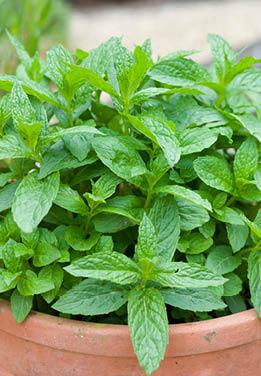
2
Mint in a clay pot.

3
Small Fruits
Strawberries can be grown in containers. Strawberry pots even have holes around the sides, which allow for multiple plants. Most small fruits are perennial and will need special care during the winter.
Woody Plants (shrubs or small trees)
To grow these successfully, larger containers will be needed. Also, choose plants that are naturally slow-growing and are small or dwarf in growth habit. Examples include various species of hawthorn (Cretaegus), birch (Betula), and oak (Quercus) trees and shrubs like viburnum (Viburnum) and euonymus (Euonymus).
If the plants grow slowly, there will be less need for pruning and repotting later. Plan on winter maintenance, including making sure containers do not dry out and are protected from the worst of Wyoming’s winter weather.
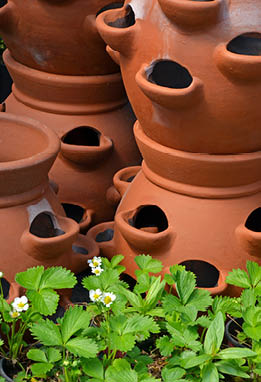
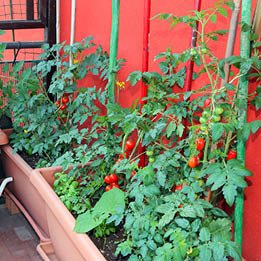
Strawberries ready for planting in clay strawberry pots.
Tomatoes with supports in plastic containers.


Vegetables
When looking for vegetable varieties that will grow well in containers, check for descriptive words like “bush,” “compact,” “dwarf,” or “determinate.” These describe varieties most suited for growing in containers. Even root crops like carrots and beets can be grown in large pots. Containers can be caged to minimize damage from wildlife. Keep in mind that vegetables require consistent moisture and are not as forgiving as many other plants. This means paying close attention to irrigation when growing vegetables in containers.
Watering
Once the plants are in the containers, watering is the most important maintenance task. Plan on watering at least twice a day if the containers are small and porous. This is particularly important if the pots are in the sun. If containers are larger and more protected, less frequent watering will be needed.
Drip irrigation systems specifically for containers are available.
Fertilizing
Fertilizing is easiest using a slow-release fertilizer. Many are on the market and, once they are applied in the spring, will last through the growing season.
Alternatively, use liquid fertilizers at rates no higher than directed on the label. Some pre-bagged mixes already contain fertilizer so make sure to read the package label.
Fall Cleanup
At the end of the growing season, vegetables and flowering annuals should be removed from the containers. Healthy plant material can be composted, but avoid this if there are insects or diseases present.
Reusing the potting mix from year to year is not recommended as the mix becomes compacted over time with fewer spaces for air and the root system. It may also harbor disease-causing organisms that may create problems the following year. To sanitize containers for the next season, scrub them using a 10-percent solution of chlorine bleach in water.
Winter Care
Perennial plants, whether herbaceous or woody, should be watered thoroughly at the end of the growing season and should be kept moist, but not soggy, all winter. This will minimize damage to the roots from freeze/thaw cycles. Containers should be kept in a protected area, away from prevailing winds, preferably out of the sun, which will prevent temperature extremes.
Rosemary and thyme in a metal container.
4
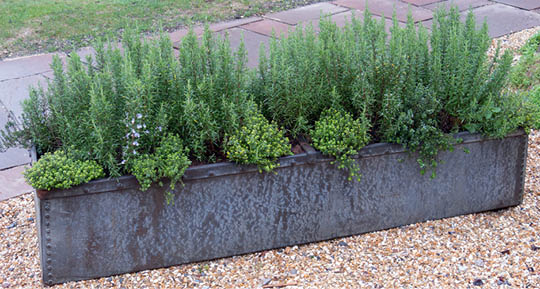

5
Sometimes, glazed ceramic pots will crack with expansion and contraction during the winter. One way to minimize this is to cover the sides (not the bottom) with bubble wrap. The bubble wrap forms an insulating layer that helps protect the container from winter temperature extremes.
For gardeners having many containers of perennials, group them together if possible and cover them with frost fabric (a lightweight cloth available from some nurseries and garden centers), straw, or leaves to protect the plants. Placing them in an area prone to drifting snow is another strategy. The snow cover will protect them from temperature extremes, maximizing plants’ chances of surviving the winter. Even better, if space is available, place the containers in a trench dug in the soil in a protected spot. Dig down almost as deep as the containers are tall, and place the containers in the trench. This heeling in process will protect the root systems from winter temperature extremes. Remember to keep them moist until spring.
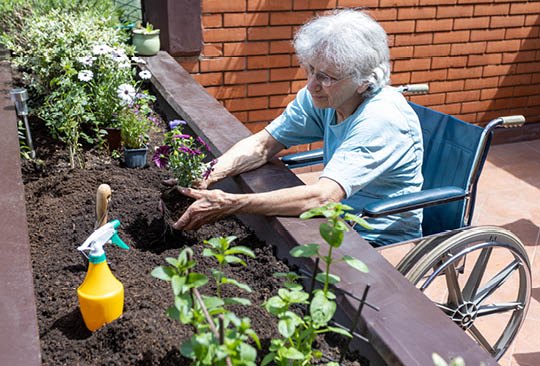
Raised container gardens do not require bending or kneeling and are more accessible.

Some plants can be taken indoors for the winter. These plants might include tender perennials like rosemary and geraniums. If plants are taken indoors for the winter, check them for insects and diseases first.

B‑1239R
Revised June 2022
Karen Panter, Extension Horticulture Specialist, Department of Plant Sciences, University of Wyoming
Chris Hilgert, Extension Educator, Department of Plant Sciences, University of Wyoming
Design: Tanya Engel, University of Wyoming Extension
Revised from B‑1239, April 2013. Karen Panter, Extension Horticulture Specialist, Department of Plant Sciences, University of Wyoming, Chris Hilgert, Extension Educator, Department of Plant Sciences, University of Wyoming.
Issued in furtherance of extension work, acts of May 8 and June 30, 1914, in cooperation with the U.S. Department of Agriculture. Kelly Crane, director, University of Wyoming Extension, University of Wyoming, Laramie, Wyoming 82071. • The University’s policy has been, and will continue to be, one of nondiscrimination, offering equal opportunity to all employees and applicants for employment on the basis of their demonstrated ability and competence without regard to such matters as race, sex, gender, color, religion, national origin, disability, age, veteran status, sexual orientation, genetic information, political belief, or other status protected by state and federal statutes or University Regulations.
6
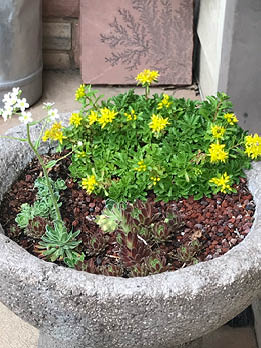
Concrete pot with perennials Saxifrage (white flowers) and Sedum (yellow flowers).

Internet addresses change and pages can disappear over time. If you find problems with any of the listed web sites in this publication, please contact
Karen Panter, (307) 766-5117, kpanter@uwyo.edu.